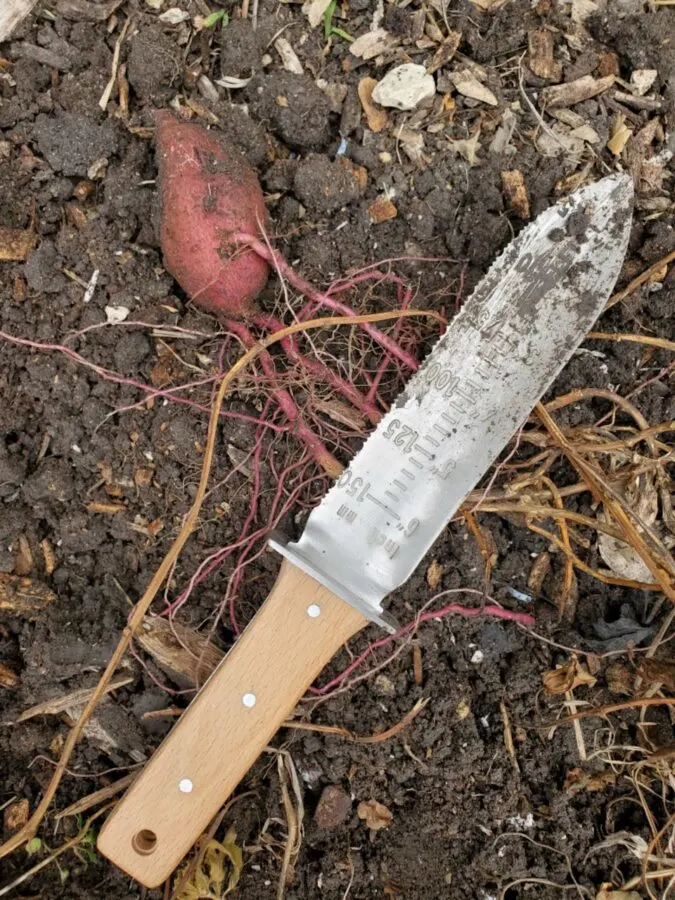Sweet potatoes are one of the most nutrient dense plants and great for beginning gardeners. Learning how to grow sweet potatoes is a great way to increase the total number of calories you can grow in a small space.
If you want to become more self sufficient and grow more of your own food, sweet potatoes should be one of the first plants you master. Not only do they have nutrient dense roots, but the leaves are edible too. You can cook and use them like spinach!
Plus, you can save some sweet potatoes to regrow your sweet potato crop year after year. Over the past few years we have seen more and more people interested in gardening, yet there are sometimes seed shortages. Any crop that you can regrow yourself without having to order more is a great safeguard.

Growing Sweet Potato Slips
Sweet potatoes don’t grow from seeds, and they don’t grow from eyes like regular potatoes. Sweet potatoes regrow from slips, or new vines that sprout out of the root. Unlike potatoes, which are in the nightshade family, sweet potatoes are related to morning glories. Slips grow from organic sweet potatoes from the store, or from last year’s crop. They can also be ordered online.
Don’t plant a sweet potato that has spouted without rooting the slips first, or you won’t get a harvest. This is one of my favorite plants to regrow because it is so easy. All you have to do is put the root partially in water. You can cut it in half and suspend the cut side in water with toothpicks.
Half the time I don’t have toothpicks and I just prop up half the potato on the side of the bowl instead.
Make sure to change the water regularly as it can get gross. Once those new vines sprout you can carefully remove them from the main root and either plant them, or continue to let the sweet potato vines grow in water.
Gently twist slips to remove them from the root. Once you place them in water they will start rooting themselves. I like to use them as a fun house plant as they are pretty vines.
You can grow slips from vine cuttings too! Cut about six inches from the ends before the first frost. Place the sweet potato vines indoors in water keep them in a sunny window until planting out in the garden.
When To Plant Sweet Potatoes
Sweet potatoes are warm weather plants, so don’t plant sweet potato sprouts outdoors until all chances of frost are past. The best time to plant sweet potatoes is when soil temperatures between 60 and 85 degrees Fahrenheit and for air temperatures ranging from 65 to 95 degrees.
The best month for planting sweet potato vines will depend on what gardening zone you are in. You can find your zone by going here.
Sweet potatoes need 100-120 growing days, so if your growing season is shorter than that from first frost to last frost you will need to use seasons extenders such as a cold frame, a greenhouse, or by pre-warming the soil. If you do have to harvest early the sweet potatoes are still edible, they will just be smaller in size, like the pictured here:

You can pre-warm your soil a month before planting in zones 3-5. Use clear builder’s plastic to take advantage of the greenhouse effect in May. Pull it tight and anchor it with dirt so that air and moisture cannot escape from underneath.
When it’s time to plant in June, cut a slit for your sweet potato slips, and anchor the edges of the plastic with dirt. Leave a depression around the plant so it can utilize rain water.
Planting Dates For Sweet Potatoes By Zone
Sweet potatoes can grow without season extenders from zone 6 and above. They really thrive in hot weather climates. If you are in zones 9, 10, or 11 you need to grow these! Here is when plant sweet potatoes in your area.
Zone 6 May
Zone 7 April-May
Zone 8 April-June
Zone 9 March-June
Zone 10a February-June and December
Zone 10b February-June
Zone 11 February-June and December
Zone 12 January
Zone 13 January
The most common variety of sweet potato is Beauregard. This is the kind you usually see in grocery stores. There are other varieties available too, such as Jewell and Vardaman. Centennial is a disease resistant type that only takes 90 days to mature, which makes it a great choice for colder zones.
How To Plant Sweet Potatoes
When it’s time to put your sweet potatoes outdoors, plant them into a loose garden bed so they can form more roots for you to harvest later. They can’t grow as well if they’re fighting packed down dirt and competing for nutrients. They’ll also do best in a spot with full sun, which is 6 hours a day or more. ake sure to rotate your crop location each season to prevent diseases.
Loosen about 12 inches of soil in your garden bed where you are going to plant your sweet potatoes. Sweet potatoes can grow in poor soil but the more you can loosen up the soil the easier time the plant will have in growing a large crop for you.
A great tool for planting and harvesting sweet potatoes is the hori hori garden knife. Emerging Green sent me one to try and I was very impressed. It’s comfortable to hold, but also very durable. (It does an awesome job at harvesting!)
You can check out the garden knife by clicking here. We’re just starting our gardening season at the moment, so I haven’t had a chance to try out the awesome measurements on the blade yet. I’m terrible about eyeballing soil depths and distances between plants, so I’m sure THAT will be helpful when planting!

When you have some roots on the bottoms of the slips, plant them in holes about 4 inches deep and 3 inches wide. Leave at least 10 inches between slips. Slips need quite a bit of water when they first get settled in, so soak the dirt after planting.
They will grow pretty large, so you’ll want to give them some elbow room for the vines to spread out. You can leave as much as three feet between rows. When the vines touch the ground, they can root there as well and create more roots for you to harvest!
Caring For Sweet Potato Vines
Water daily for the first week and then gradually taper off one day at a time. So water every other day second week. On the third week every three days, etc until you are only watering once a week. They’ll need about 1 inch of water at each watering.
Do let the ground dry between watering though, don’t keep it constantly moist after the slips get established. Then stop watering during the last couple of weeks before harvesting to prevent the roots from rotting.
Make sure not to over feed or fertilize during the growth season. It will cause leaf growth instead of root growth and you’ll have underdeveloped roots. You can eat leaves during growing season like spinach, just make sure to leave enough to support the plant.
There are a few pests and diseases that will go after your sweet potatoes. If they get leaf spots, thyme oil can help treat it. And if you find beetles or weevils, try using some garlic juice extract to discourage them.
Harvesting Sweet Potatoes
Knowing when to harvest is pretty easy. As soon as your first frost hits it will kill the vines. When you notice the leaves have turned yellow, this is when you should dig up your roots. As you dig, be careful to not to damage the skin of the sweet potatoes as it will cause them to go bad faster.
My favorite tool to harvest sweet potatoes is the hori hori garden knife. The serrated edge cuts through the vines super easily. It’s not too big, which makes it easier to be careful of the roots while digging. Plus the blade is strong which makes digging in tough Texas soil a little bit easier.

After harvesting, let the potatoes cure for a couple hours outdoors, and then when you first bring them in, wrap them in newspaper. After curing for two weeks the sweet potatoes can be stored in a cool dry place all winter. The won’t do well in the fridge as it is too cold and humid.
If you prefer to freeze your harvest, cooked sweet potatoes will freeze well and don’t need blanched or other special preparation.
Enjoy Your Sweet Potatoes!
Sweet potatoes are a great crop for the self sufficient gardener, but they won’t benefit you if you don’t actually use them. You can use them to supplement your chicken feed. My favorite way to eat sweet potatoes is as fries, however they are great roasted too.
I hope you plant this excellent vegetable and have great success in growing it!
Make sure you check out the hori hori garden knife before your next gardening season, and share in the comments your favorite part about growing sweet potatoes!
Sources:
Texas A&M Agrilife Extension
Mother Earth News
Gardenate
Want To Raise Happy Chickens?
Subscribe for our newsletter and get the free email course Intro To Backyard Chickens as well as a free printable checklist to walk you through step by step!
